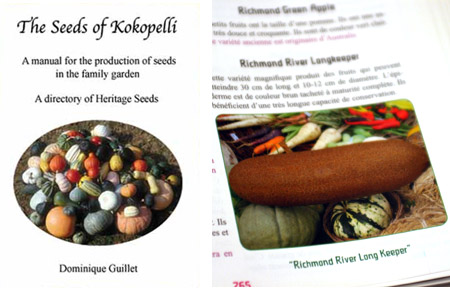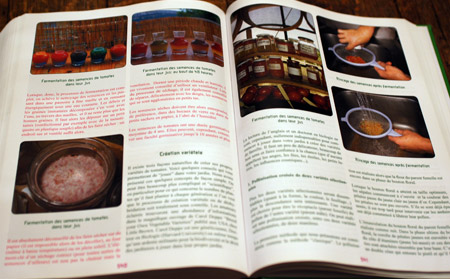
I want this book! We took a week off last month, staying at the home of an avid tomato gardener whose name I have not sought permission to reveal (and therefore will not). While there she introduced me to the Kokopelli Seed Foundation, a non-profit organization based in France who are working to actively address issues of food security and preserve biodiversity by producing organic open-pollinated seeds as well as educating and promoting these issues globally.
One of their projects is the book, “The Seeds of Kokopelli” by Dominique Guillet is a massive 440 page, hardcover tome introducing Kokopelli’s work and farms, as well as proper pollination, seed production and saving techniques for an assortment of vegetables. The bulk of the book functions as a food plant directory introducing thousands of open-pollinated and heirloom herb and vegetable varieties. My host had the French version of the book at her home
(“Les Semences de Kokopelli“) which proved to be a bit of a tease given that I could only gaze at the photos, picking up a line or two of French here and there. Even still, on quick glance the book introduced me to a few interesting varieties that I’ve got on my list for next year including:
- Cucumis myriocarpus – Non-edible, but highly decorative and weird cucumber relative.
- ‘Kaiser Alexander’ Cucumber – Another freaky, but edible cucumber with a strange brownish, ridged skin reminiscent of cantaloupe.

What I saw has absolutely convinced me to order a English edition for myself. $46 (includes shipping to Canada) is an excellent price for such a massive encyclopedia of plants. The price including shipping to the US is a deal at $34-38.
Does this book contain information on fruits? Or is it just vegetables? I am thinking I need to order a copy . . . :)
Hi Audrey,
I do not recall fruit in the book although there may have been a few things that straddle the line between fruit and veg i.e ground cherry. I think even without the seed-saving information (advanced gardeners may not need this) the book functions as an excellent catalogue or encyclopedia of interesting varieties.
I have the book and it is essentially a perpetual seed catalogue (although that doesn’t do it justice because it is fascinating).
It is divided up into vegetable families, and the number of fruits used as fruits is limited to melons, water melons and physalis (judging by a quick flick through and the index).
The C. myriocarpus looks like the ugly love child of a watermelon and a gooseberry. Thanks for giving me something to put on the order list!
very cool Gayla!
I love gardening – always nice to find new and exciting gardening sites out there!